It is a delicious and healthy fruit that is loved by millions of people across the country. Watermelon is a member of the large Cucurbitaceae family of plants, a group that includes most vining vegetables, including Cucumbers, Squash, and Pumpkins. All you need is well-drained soil, seed, water, and sun, and you will be on your way to growing a delicious Watermelon. The below article explains the step-by-step process of Watermelon farming in California below.
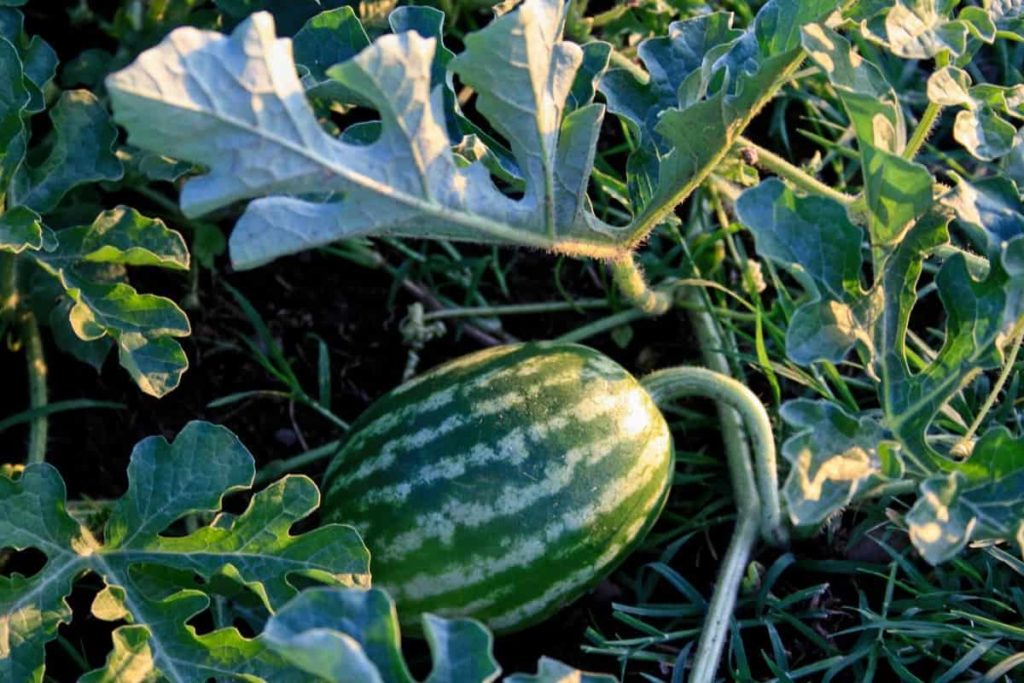
Watermelon farming in California
Factors affecting Watermelon crop growth
Many aspects of crop development affect growth, and a lack of these can throw these dates off. These include;
- Climate conditions
- Soil quality
- Water use
- Availability of sunlight
- Geographical location
Watermelon varieties cultivated in California
Seed varieties
Fiesta and Sangria varieties are popular all-sweet hybrids with long, dark green, broken, light green stripes. Calsweet, the most popular open pollen, has skin and red flesh. A hybrid royal sweet suite with striped skin and deep pink flesh is also grown. Sultan is a fast-maturing, high-yielding hybrid. Icebox Watermelon varieties grown in North San Joaquin Valley include Sugar Baby, Baby Doll, and Tiger Baby.
Seedless varieties
Seedless varieties have recently accounted for at least 30% of the California Watermelon acreage. Commonly used seedless types in desert valleys include Nova, Laurel, Wonderland, Fire Cracker, Quality, Ultra-Cool, Millionaire, AC 532, AC 5032, and AC 5244. Due to the high seed cost of $ 700 to $ 1,200 per pound and low seed power, triploid varieties are almost always transplanted.
The cost of transplanting seedless Watermelon is 28 to 35 cents. Seedless Watermelons require one row of pollinator plants for every two to three rows of seedless plants. Royal Sweet, Calsweet, and Sangria are mainly used as pollinators. Fruits from the pollinators are sold as a separate product.
Watermelon planting time in California
July, August, September, October, November
Soil and light requirements for Watermelon farming
The Watermelon plant needs full sunlight to thrive. It can tolerate some partial shade, especially in hot weather, but sunlight is essential for the growth of sugar in melons. Excessive shading conditions will reduce the size and number of fruits. From light acidic to neutral soil, pH is 6.0 to 6.8. It is advisable to replace the soil with plenty of organic matter before planting, as these are heavy nutrients.
Watermelon growing areas in California
Watermelon (Citrullus lanatus) grows in the Northern Central Valley (Sacramento and Stanislaus Counties), Central Valley (Kern and Tulare Counties), and the Southern Deserts (Imperial and Riverside counties). Across the state, Watermelons are planted from mid-May to late October for planting from December to early July. Under ideal conditions, the yield reaches 40 tons per acre (90 tons/hectare). Low yields often reflect lower Watermelon prices as most of the crop remains in the field.
In case you missed it: Watermelon Farming in USA: How to Start, A Step-by-Step Guide for Beginners
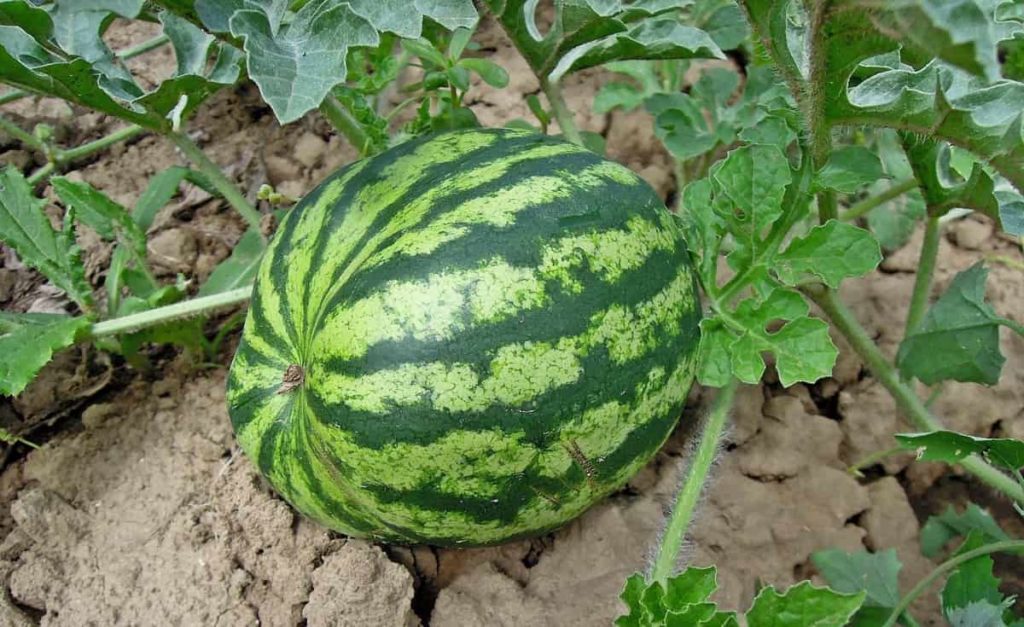
Conventional Watermelon planting in California
In the deserts of Southern California, seeded Watermelons are grown on 80-inch (2-m) south-facing beds. The beds are tilted 35 to 37 degrees to the south to capture incoming sunlight at close vertical angles, increasing the absorbed energy. Using random flow or a good air planter, Watermelon seeds are sown to a depth of about 0.5 inches (1.2 cm). After thinning the plants 2 to 3 feet (60-90 cm) depending on the variety, farmers work on the beds to change the seed line, shaving the soil from the top and putting it in the furrow.
After several passes with discs mounted on a small tractor, the field is practically smooth, with seed lines spaced 80 inches (2 m) apart. Side dress fertilizer is applied, and new fertilizers are made for irrigation. In the northern San Joaquin Valley, these are planted on flat beds 80 inches (2 m) wide and 8 to 12 inches (20-30 cm) high. The seed is kept from 0.5. 0.75 inches (1.2–1.9 cm) depth. After thinning and side-dressing, furrows are reformed before irrigation.
Another way to plant spring Watermelons in extremely cold weather is to use plastic bed mulch, transplants, and drip irrigation. A 72-inch (1.8-meter) wide black plastic film is spread on 80-inch (2-m) beds to heat the soil and reduce weeds. Approximately 6 inches (15 cm) of plastic is tucked into the edges to hold the mulch. Beds usually have a single drip irrigation tape placed approximately 6 inches (15 cm) below the surface. Transplants are placed at a distance of 24 to 36 inches (60-90 cm).
Irrigation management
Irrigation should be continued until the beds are entirely wet. After emergence, the water can be stopped for a long time. Watermelon should not be stressed for watering after the plants have borne fruit. Inadequate irrigation will result in a smaller size of a melon and more rot at the end of flowering. Excessive irrigation after water pressure on melons can result in fruit breakage.
In case you missed it: Top 20 Steps to Boost Watermelon Yield: How to Increase Fruit Size, Quality, and Production
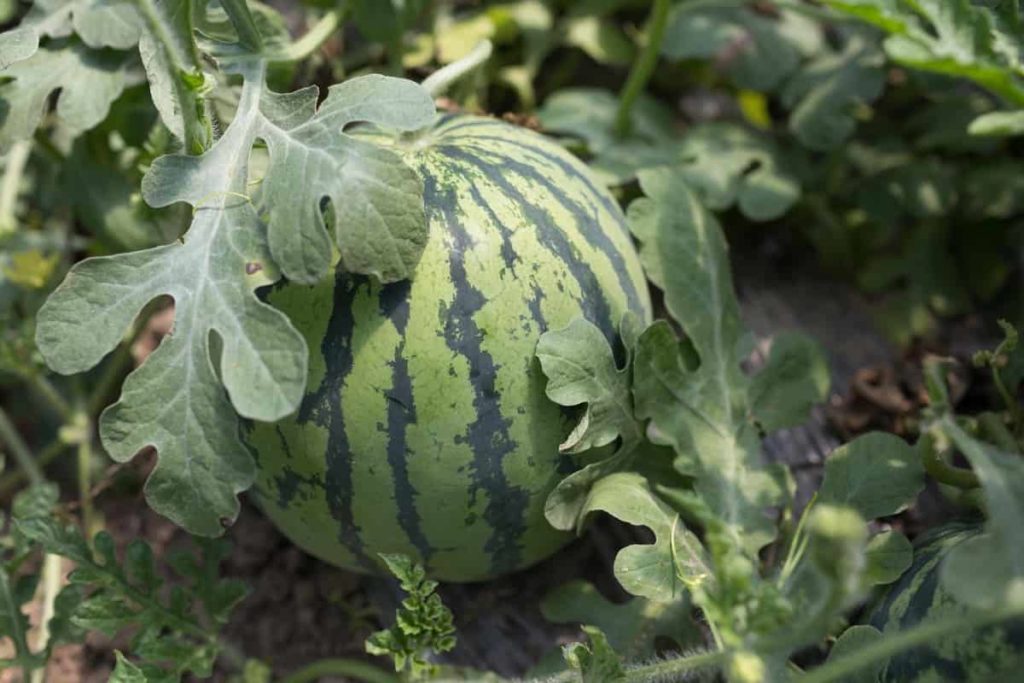
Watermelons need to be watered regularly when they are first transplanted. Once they begin to bear fruit, you can rest on the water unless it is particularly dry. Their roots are deep, and they can withstand short dry periods. If too much water is given, they will lose their sweetness. Water plays an essential role in keeping Watermelon vines healthy and delicious fruits. Watermelon vines are most susceptible to drought, from planting to fruiting.
Avoid overhead watering. Drip irrigation delivers water directly into the soil, helping to prevent the possible spread of fungal diseases in plants. Keeping the soil moist but not full of water will kill the plants. It is common for plant leaves to wither in the midday sun, but they should not wither until evening. Water the vines early in the morning so the leaves dry out before sunset, which will further help prevent fungal diseases.
Fertilizer requirement for fruit growth
Watermelon plants are heavy feeders. Soil is well-modified with organic matter before starting planting. If soil is deficient in organic matter, apply organic fertilizer at the season beginning. To maintain the Watermelon growth, side dress with a layer of fertilizer in the middle of the season.
If you use chemical fertilizers for crop growth, apply a fertilizer with more nitrogen than phosphorus and potassium, as it will promote vine growth. But after flowering begins, fertilize the plant a second time with a low nitrogen fertilizer that encourages fruit and flower growth.
Watermelon plant care
- It is essential to make sure that the Watermelon has enough water. Water the soil regularly but avoid getting the leaves wet. You can also apply mulch to make sure the soil is not dry.
- Watermelons take a long time to ripen, so feeding them regularly with high-quality fertilizer is recommended.
- When the fruit is about the size of a softball, place it on a bed of cardboard or straw to prevent rot.
- About a week before the melon ripens, water the plant only to prevent it from withering. It will help the Watermelon concentrate the sugar in the fruit for delicious Watermelon.
- Mulching with black plastic or straw around plants will serve several purposes: warm the soil, stop grass growth and keep the fruit growing from the soil.
- Pruning is not usually necessary for Watermelon plants, but if you do not allow the lateral (side) vines to grow and then stick to the central vines, the productivity of the vines may improve.
- When the plant is young, cut off only the last buds as they form (before the side shoots become vines). You can also pinch some flowers to focus energy on fewer melons (although eliminating any potential fruit is challenging).
In case you missed it: Organic Watermelon Farming, Growing Practices
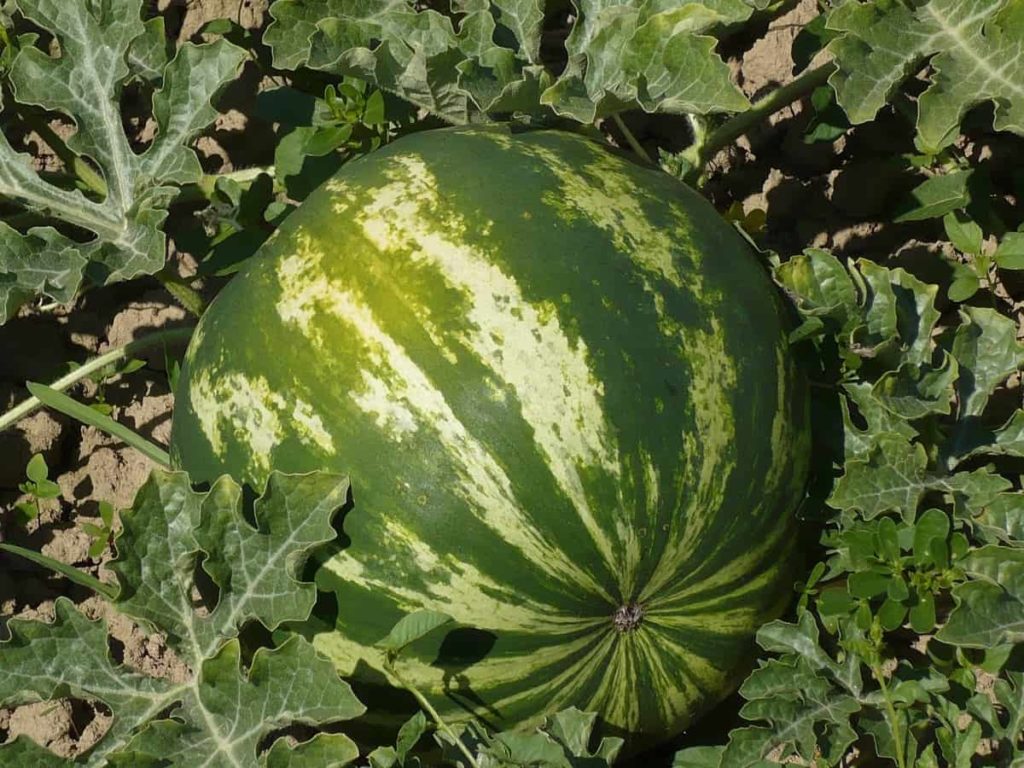
Watermelon plant pruning
Some Watermelon growers prefer to prune their own, while others claim that harvesting Watermelon delays plant growth and fruit set. People who prune their plants quickly remove most of the plant’s peripheral veins during the first stages of development, when it has only 3-4 veins. In this way, they force the plant to grow further through the central vein. They remove excess vegetation, which prevents adequate ventilation throughout the growing season. It protects the plant from humidity-favored infections, such as powdery mildew.
Troubleshooting in Watermelon farming
Watermelons, squash, and cucumbers belong to the same family of plants but do not pollinate successfully. Your garden will depend on bees for pollinating flowers, so cold, cloudy weather in spring will slow down their growth, as bees are less active in such conditions. Wait until the weather warms up.
The most serious pests are whiteflies, cutworms, beetle armyworms, aphids, spider mites, darkling ground beetles, leafhoppers, cabbage loopers, and leaf miners.
Silver Leaf Whitefly is also a vector for two viral diseases (Cucurbit Yellow Stunting Disorder and Cucurbit Leaf crumple) that affect Watermelon production and quality.
Fungal diseases can spread rapidly on Watermelon leaves. In addition, anthracnose, and gummy stem blight spots on the leaves, while stem defects also form bleached or tanned parts on the stem and rot on the fruit.
Downy mildew causes yellow or light green spots on the leaves, while powdery mildew causes white spots on the leaves. Treat fungal diseases by using fungicides and check with the local garden center to find which fungicides are approved in the state for the disease you are fighting. Also, look for insects. For example, melon aphids can quickly settle vines, so inspect the underside of the leaves daily. If you see aphids, treat them with insecticide.
Striped cucumber beetles can attack vines and transmit bacterial wilt disease, causing the vines to fall without a chance of recovery. Treat adult beetles with rotenone or pyrethrum-based insecticide. Apply in the evening to avoid harming the bees.
In case you missed it: Watermelon Seed Germination, Time, Temperature, Process
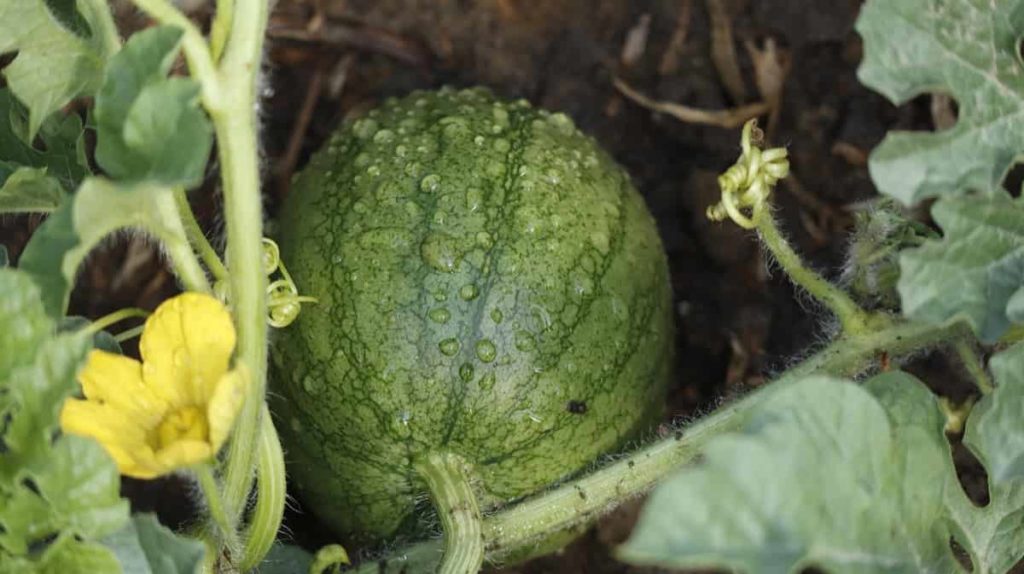
Because Watermelon varieties and hybrids are susceptible to powdery mildew, fungicide sprays are needed to control the disease. Prevention spray programs with fungicides can be effective, but the fungus quickly develops fungicide resistance, often in the same season.
Anthracnose – The fungus that grows from this seed is difficult to detect early, as it can only appear as small spots on your plants and fruits. As it grows, these spots spread and turn black or gray, and new sunken areas may appear on your fruit. Crop rotation combined with aggressive neem oil treatment will help protect this and future crops from anthracnose.
Powdery mildew – One of the most common plant diseases, powdery mildew does not cure Watermelon either. When the infection is active, white powdery substances will appear on the leaves, although the fruits are not usually affected. As the powder fungus passes through the plant, the leaves turn brown and die, causing the fruit to burn in the sun and weaken the plant. Neem oil is an excellent remedy, but it can also be effective in increasing the air circulation around the Watermelon plant.
Harvesting time for Watermelon farming in California
The criteria for picking Watermelon include color change (most reliable), blossom end conditions, and rind toughness. Melons extracted from vines can open. Harvested fruit is transported to nearby roadways, often located beyond ten beds. The pitching crew follows the cutters, pitches the melons from one hand to the other, loads them into trucks, and takes them to a shed. Melons should never be planted on flower heads as they may break too much.
As mentioned above, there are over 1200 different varieties of Watermelon. Many of these Watermelon harvesting periods will be different. To get the most out of Watermelon plants, you’ll want to know when it’s harvesting time and the type of Watermelon you’re planting. It is important to remember that small Watermelons will ripen faster than large ones.
To find out when your Watermelon is ready to be harvested, look at the tendril closest to the melon stem (stem in the form of a spiral coil). When it turns brown and dries, the melon is ripe. You should also check the color of the area where the melon is sitting on the ground. When the spot turns white to yellow, it is ready for harvesting. Your main Watermelon ripens about 65 to 90 days after you plant the seeds. Then you have Watermelons that are small in size and weigh 2 to 4 pounds.
In case you missed it: Watermelon Profits, Yield Per Acre, Growth Stages
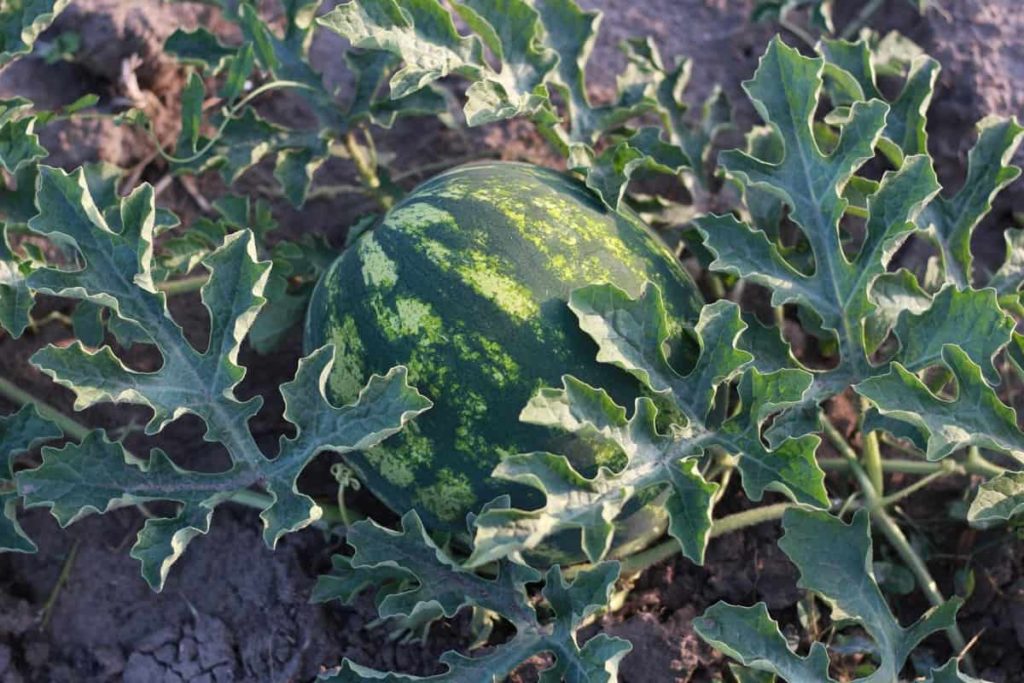
Marketing
California produces approximately 330,000 tons (302 T) of Watermelons annually (1.95 million for the United States. A limited supply of California Watermelon is available in early May. Watermelon farming peaks in August, and the season ends in November. Most California Watermelons are sold in the western United States and Canada. The biggest competition in the market comes from Mexico, Arizona, and Texas.
Conclusion
Watermelons grow well in almost any well-drained rich soil. The soil, light, and temperature levels are essential factors for the proper flowering of the Watermelon crop. The above factors contributed to the success of Watermelon farming in California.
- Economical Aquaculture: A Guide to Low-Budget Fish Farming
- 15 Common Planting Errors That Can Doom Your Fruit Trees
- How to Make Houseplants Bushy: Effective Tips and Ideas
- Innovative Strategies for Boosting Coconut Pollination and Yield
- Pollination Strategies for Maximum Pumpkin Yield
- The Complete Guide to Chicken Fattening: Strategies for Maximum Growth
- Natural Solutions for Tulip Problems: 100% Effective Remedies for Leaf and Bulb-Related Issues
- Revolutionizing Citrus Preservation: Towards a Healthier, Greener Future
- Natural Solutions for Peony Leaf and Flower Problems: 100% Effective Remedies
- Maximizing Profits with Avocado Contract Farming in India: A Comprehensive Guide
- Natural Solutions for Hydrangea Problems: 100% Effective Remedies for Leaf and Flowers
- The Ultimate Guide to Choosing the Perfect Foliage Friend: Bringing Life Indoors
- From Sunlight to Sustainability: 15 Ways to Use Solar Technology in Agriculture
- The Ultimate Guide to Dong Tao Chicken: Exploring from History to Raising
- The Eco-Friendly Makeover: How to Convert Your Unused Swimming Pool into a Fish Pond
- Mastering the Art of Delaware Chicken Farming: Essentials for Healthy Backyard Flocks
- 20 Best Homemade Fertilizers for Money Plant: DIY Recipes and Application Methods
- How to Craft a Comprehensive Free-Range Chicken Farming Business Plan
- Brighten Your Flock: Raising Easter Egger Chickens for Beauty and Bounty
- How to Optimize Your Poultry Egg Farm Business Plan with These Strategies
- Subsidy for Spirulina Cultivation: How Indian Government Schemes Encouraging Spirulina Farmers
- Ultimate Guide to Raising Dominique Chickens: Breeding, Feeding, Egg-Production, and Care
- Mastering the Art of Raising Jersey Giant Chickens: Care, Feeding, and More
- Ultimate Guide to Raising Legbar Chickens: Breeding, Farming Practices, Diet, Egg-Production
- How to Raise Welsummer Chickens: A Comprehensive Guide for Beginners
- How to Protect Indoor Plants in Winter: A Comprehensive Guide
- Ultimate Guide to Grow Bag Gardening: Tips, Tricks, and Planting Ideas for Urban Gardeners
- Guide to Lotus Cultivation: How to Propagate, Plant, Grow, Care, Cost, and Profit
- Agriculture Drone Subsidy Scheme: Government Kisan Subsidy, License, and How to Apply Online
- Ultimate Guide to Raising Araucana Chickens: Breed Profile, Farming Economics, Diet, and Care
- Bringing Hydroponics to Classroom: Importance, Benefits of Learning for School Students
- Ultimate Guide to Raising Polish Chickens: Breed Profile, Farming Economics, Diet, and Care
- Ultimate Guide to Raising Australorp Chickens: Profile, Farming Economics, Egg Production, Diet, and Care
- Silkie Chicken Farming: Raising Practices, Varieties, Egg Production, Diet, and Care
- Sussex Chicken Farming: Raising Practices, Varieties, Egg Production, Diet and Care
- Homemade Feed Formulations for Livestock: Discover Cost-effective Starter to Finisher Feed Recipes